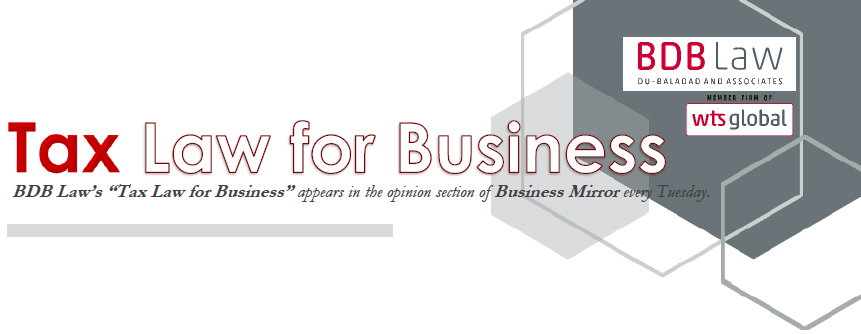Atty. Fulvio D. Dawilan discusses the new substantiation and procedural requirements for the deductibility of losses arising from inventories and other assets considered as waste or obsolete.

Deductibility of Loss from Destruction of Inventories/Assets
By: Atty. Fulvio D. Dawilan
"The confusion on the requirements for the deductibility of losses arising from destruction/disposal had come to light with the recent issuance of RMO 21-2020."
The deductibility of loss arising from the write-off or destruction of inventories and other assets had always been a cause of dispute between taxpayers and the tax authority. A number of tax examinations had led to the disallowance of deductions claimed by taxpayers on losses arising from the destruction/write-off of inventories and assets due to obsolescence, deterioration or other causes rendering them unfit for sale or use. Apparently, the BIR had consistently advanced the view that a prior approval andIor the presence of a representative from the BIR is necessary before goods/assets write-off/destruction could be made and claimed as deduction for income tax purposes.
 Specifically with respect to inventories, a review of previous assessment cases that were elevated to the Courts would show that the BIR had been taking the position that for a deduction on account of a taxpayer's destruction of inventories due to obsolescence to prosper, there is a mandatory substantiation requirement to be satisfied. And that is the issuance by the BIR of a document affirming the fact that the inventory was indeed destroyed. That can only happen if the BIR is notified by the taxpayer and a representative is sent on a specified date to witness and attest to the destruction of the inventory.
Specifically with respect to inventories, a review of previous assessment cases that were elevated to the Courts would show that the BIR had been taking the position that for a deduction on account of a taxpayer's destruction of inventories due to obsolescence to prosper, there is a mandatory substantiation requirement to be satisfied. And that is the issuance by the BIR of a document affirming the fact that the inventory was indeed destroyed. That can only happen if the BIR is notified by the taxpayer and a representative is sent on a specified date to witness and attest to the destruction of the inventory.
To justify the disallowance, it is the usual argument by the BIR that the issuance of a certificate is the only rational requirement that effectively substantiates a claim that inventory was destroyed. Otherwise, the government would be left with no recourse but to accept a regime where taxpayers substantiate self-serving claims through their own records and their own interested witnesses. Should there be no prior BIR approval nor a request for a BIR representative who would witness the actual write-off as part of the substantiation requirement, the cost of inventories written-off is considered unreliable and cannot be allowed as deduction from taxpayer’s gross income.
Was there really a requirement for a taxpayer to have the destruction of its inventories/assets witnessed by a BIR representative and for the latter to issue certification on his observation? None. That may have been the practice, but that is not provided in the law nor in any revenue issuance. In fact, while the Courts had agreed on the disallowances made by BIR examiners on a number of occasions, it was not on the absence of actual witnessing by a BIR representative and non-issuance of certification. The Court had in fact acknowledged that a certification from the BIR of the actual destruction of obsolete inventories is not necessary in order that the costs of written-off assets could be claimed as deductions. A taxpayer needs only to present competent documentary evidence to establish such destruction and the related costs. Failure to substantiate an inventory write-off would justify the disallowance of the deduction.
In essence, actual witnessing by a BIR representative of the destruction of inventories and the issuance of a certification would serve as proofs for claiming the costs of written-off/destroyed inventories as deductions. But that is not necessary and certainly not the only means. Some other reliable proofs, other than self-serving pronouncement by the taxpayer, would serve the same purpose.
Even the issuance of Revenue Memorandum Order (“RMO”) No. 16-2012 was vague on this requirement. Although the RMO prescribed the policies and guidelines for the required physical/ocular inspection and supervision over the destruction/disposal of equipment or of inventory of goods or assets which have been declared, among others, as waste or obsolete due to different causes rendering the same unfit for sale or for use in production, before it can be considered as deductible, it was referring to casualty losses. The term "casualty" is the complete or partial destruction of property resulting from an identifiable event of a sudden, unexpected, or unusual nature. It does not apply to losses arising from ordinary deterioration of assets from operating causes. Also, it was referring to cases where the inventories, machineries or equipment applied for destruction are located outside the territorial jurisdiction of the BIR office where the taxpayer is registered. It would seem that it did not cover goods/assets located within the jurisdiction of the BIR office where the taxpayer is registered.
The confusion on the requirements for the deductibility of losses arising from destruction/disposal had come to light with the recent issuance of RMO 21-2020. Prescribing the policies, guidelines and procedures for the inspection or supervision of the destruction/disposal and determination of deductible expense pertaining to inventory of goods/assets which have been declared as waste or obsolete, the RMO requires an application for destruction/disposal of goods/assets to be filed with and processed by the concerned BIR office where the principal place of business of the taxpayer is registered. An application has to be filed at least seven days before the proposed scheduled date of destruction/disposal of the inventories/equipment.
21-2020. Prescribing the policies, guidelines and procedures for the inspection or supervision of the destruction/disposal and determination of deductible expense pertaining to inventory of goods/assets which have been declared as waste or obsolete, the RMO requires an application for destruction/disposal of goods/assets to be filed with and processed by the concerned BIR office where the principal place of business of the taxpayer is registered. An application has to be filed at least seven days before the proposed scheduled date of destruction/disposal of the inventories/equipment.
Among other documentary and procedural compliance, the new RMO also requires actual witnessing of the destruction of a representative of the BIR, who must later issue a Certificate of Deductibility. Interestingly, an accredited tax practitioner or external auditor may also be a witness. The certificate issued by the witness shall be the basis of the taxpayer in claiming deductions. Clearly, before a loss is recognized as a deduction, it is now mandatory for a BIR authorized representative to witness the actual destruction of inventories and other kinds of assets and to issue certification on his observation.
With this new RMO, there is now clarity on the requirements before a loss on inventories and assets which have become waste or obsolete due to spoilage, deterioration, oblsolescense, expiration, or other causes rendering the asset unfit for sale or for use in production. Taxpayers should follow the guidelines provided in the RMO, with the certificate issued by the BIR as the primary document to support a claim for deduction. Taxpayers cannot rely on other documents to substantiate their deductions, no matter how significant such other documents are. These may only serve as additional proofs. But compliance with these requirement apply only to losses resulting from actual destruction and not to other reasons. Certainly, it does not apply to losses from sale of inventories and assets sold at less than their carrying values.
The author is the Managing Partner of Du-Baladad and Associates Law Offices (BDB Law), a member-firm of WTS Global.
The article is for general information only and is not intended, nor should be construed as a substitute for tax, legal or financial advice on any specific matter. Applicability of this article to any actual or particular tax or legal issue should be supported therefore by a professional study or advice. If you have any comments or questions concerning the article, you may e-mail the author at This email address is being protected from spambots. You need JavaScript enabled to view it. or call 8403-2001 loc 310.



